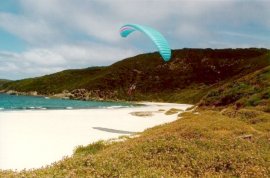Western Australia > Albany and South Coast
Shelley Beach

| Type | Coastal Ridge |
| Conditions | ESE-SSE |
| Height | 85m |
| Rating | PG2 / HG Supervised |
Turn Left off Lower Denmark Road at the signposted turn off to Cosy Corner. Turn Right up hill after the Torbay Hotel, then left onto a good gravel road at the top of the hill. Follow this to the end where it splits right to the lookout/takeoff and left down to the bottom landing, beach and camping ground. National Park fees apply (West Cape Howe National Park). A Parks Pass is advisable if flying here for multiple days in a year. There is camping right at the LZ, or nearby Cosy Corner East.
Landowners
Department of Bio-Diversity, Conservation and Attractions (DBCA, West Cape Howe National Park. National Park fees apply.)
Contact
Albany Hang Gliding ClubResponsible
Albany Hang Gliding Club, DBCA - Albany ((08) 9842 4500), 120 Albany Highway ALBANY 6330See also
Description
One of the best known coastal sites in WA, a large coastal site suitable for beginners with fantastic scenery, good access and a developed take off area with wooden hang glider ramps.
Takeoff
Takeoff is from the top lookout hill. Be aware of potential rotor coming up the face of the hill in easterly winds. The site is mostly unflyable when the wind is much further around than south. Consult the Duty Pilot / Safety Officer on launch for a site briefing if you are new to the site.
Landing
Top landing is possible given enough height. Approach from over the hangglider set up area at the western end of the hill, diverting backwards over the carpark to lose altitude if necessary. Keep an eye on your decent rate, as many people don't appreciate gliders draped over their cars, or worse the pilot themselves. If necessary, push forwards out in front of the launch and go around. Be aware that the wind on the hill can be quite strong compared to what you feel in the air. It's not uncommon for a pilot to touch down and then get plucked backwards as they try to drop their wing. Wind from a more easterly direction is known to often have quite a bit of rotor as it comes over the hill, so be out of your harness early in case there's a sudden drop.
Beach landing is also common, and may be preferable depending on the wind strength and direction. Do not land in the carpark, the valley directly behind the campground is known to produce a decent venturi straight into tiger snake territory. The beach is usually quite wide so you have space to make a semi-crosswind/upwind landing. Be aware of people fishing from the beach, especially during salmon season, as fishing rods are like trees: they jump out at you at the last moment. The creek that flows out from the valley can often prove to be a trip hazard. Avoid where possible.
Flight
Be aware of other pilots attempting to top land when setting up. Rotor behind take off and at often at SW end of main ridge (in the bowl). There is a steep valley between the take-off hill and the main ridge. In more Southerly winds the main ridge may be unflyable due to rotor, but the take-off hill can be OK. In a more Easterly wind the take-off hill will generate a bit of rotor and very little lift and it may be necessary to glide straight across to the main ridge. This can make top landing impossible if the wind is light as the valley cannot be crossed back with sufficient height. There is a substantial wind gradient at take-off so the wind may be stronger than it feels on the ramp.
No commercial activities including teaching and tandems are permitted in the National Park without the relevant DBCA permit. Flying from Shelley is an approved activity in the National Park Management Plan.
Hazards / Comments
Due to the site's scenic popularity, there is often tourists on launch. Please be respectful and maintain your distance where possible. Call out your landings if the area is not clear, or get someone on launch to clear it for you. Another potential hazard is drones. Again due to the scenic popularity, some tourists may try to launch a drone. Alert the Duty Pilot / Safety Officer of the day on launch and they will ask the drone pilot to land immediately.
This is a wilderness area. Wildlife is to be expected. There are often a couple of kangaroos that graze on the landing zone around sunrise and sunset. Keep an eye out for them, as they can be hard to spot from the air in low light conditions. Snakes are also a possiblity, but less common.